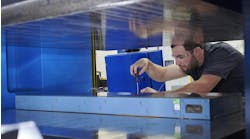Magnetic suction strainers offer dual protection to pump inlet without risk of cavitation. They are available in sizes from 1 to 3 in. with standard 30 mesh screen (560 µm). Ceramic magnets parallel to mesh attract and protect against damaging ferrous particles of all sizes. Pleated stainless-steel screen provides additional filtration for larger particles. Open area of screen eliminates pump cavitation.
Parker Hannifin Corp., Hydraulic Filter Div., (800) 253-1258, www.parker.com/hydraulicfilter



